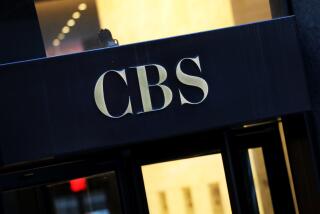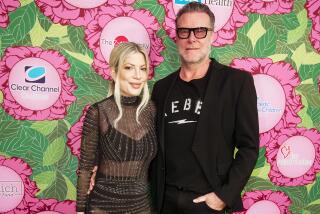Bovine intervention
IF the question is: What farm animal is least likely to have a secret life? the answer would have to be: Cows.
Why? Be-cows. No, seriously -- look at them. The face: expressionless. The movement: minimal, except for cud-chewing, ear-flicking and the occasional swatting of flies. Main contributions to society: Depleting the ozone, and producing milk and cheese.
But it’s the very boring-ness of the bovine, the dullness of the dairy denizen, that inspired Los Angeles photographer Glen Wexler to create “The Secret Life of Cows” -- a book of surreal images created with digital imaging technology, with a foreword by “Monty Python” member Eric Idle, and an exhibition that opens today at Bergamot Station’s Track 16 Gallery.
Wexler’s work suggests there is another side of the cow that doesn’t look exactly like, well, the other side of a cow.
“If they are doing anything other than being boring, it’s unexpected,” Wexler says. “If you put them in these kind of death-defying situations where they are ineptly trying to defend their species, you can’t help but come up with funny images.”
But, Wexler adds, there is also a dark side. (Which makes for a three-sided cow, but who’s counting?) “If the work is viewed in the context of factory farming, or the perspective of the vegan, the images of the cows ineptly defending themselves can be perceived as more pathetic than funny,” he observes. “It really is in the eye of the beholder.”
The 50-year-old artist, a graduate of Pasadena’s Art Center College of Design, portrays the iconic black-and-white cow as invader from outer space; in contemplative mode in the cover shot “Divine Bovine”; and as debonair “Secret Agent Cows,” including Max Suede and white-jacketed casino card-shark Filippe Mignon.
There is also an action-packed series of “Super Hero Cows,” among them a caped crusader known as the Swatter; the Gristle Missile in a revealing red unitard; the mostly-metal Cowborg; and wild-eyed Decibell, able to shatter windows with a single moo.
Then there’s a bit of Brit beefcake on an album cover featuring four bowl-cut bovines for “Meat the Beefles,” from Cowbel Records. According to the text, the circa 1960 vinyl includes the hits “Twist and Moo” and “I Want to Hold Your Tail.”
“I think cows are hysterical. They look hysterical when they are standing there chewing their cud and looking at you when you are bearing down on them,” says Track 16 Gallery owner Tom Patchett. “Most animals would say: ‘Run for your life, something’s coming,’ but they just sort of wait until it’s too late.”
That’s why, when Wexler approached Patchett about doing a book signing at Track 16, Patchett offered a counterproposal: A signing accompanied by a gallery exhibition of large-scale cow photos, averaging 6 feet wide, with one that approaches 9 feet. Patchett was already familiar with Wexler’s work from the artist’s 2005 retrospective book, “25:25,” and exhibition of the same name at the Farmani Gallery in Los Angeles.
Wexler is the first to point out that he did not discover the art in the cow -- rather, he was steered in that direction by his extensive commercial work.
The photographer, who has created fanciful images for Quincy Jones Productions and album cover photographs for recording artists including Michael Jackson, Van Halen, KISS and ZZ Top, created his Super Hero and Secret Agent cow images for annual “cow-lendars” created to promote Chick-fil-A, a restaurant chain. “They have this ongoing campaign every year where they use cows to advocate to people to eat chickens instead of them,” Wexler says.
Another photograph for the book was inspired by Idle and his creative relationship with cows that began with the 1975 movie “Monty Python and the Holy Grail” and continued in “Spamalot,” the Broadway musical begat by the film. In this photo, French knights prepare to launch a cow over a castle wall at the unsuspecting Englishmen. Idle agreed to write the foreword in part because he was touched by Wexler’s depiction of “one of the sacred cows of history,” and because he and Wexler have kids who attend the same school.
Also, Idle says, “Cows are funny creatures because they start with a C.” Both K and C, he points out soberly, are funny letters. “That’s why ‘chicken’ is so funny -- it has both, doesn’t it?”
In his foreword, Idle describes Wexler as “a seven-foot Scotsman with a wooden leg whom I met Frog Rolling on an Eskimo trip in Northern Greenland. We were sheltering in a sauna at a local bordello with an Icelandic babe called Splut ... no, I agree, it’s a hopeless and pathetic lie.”
But Wexler chose to turn the pathetic lie into a sur-reality by creating a self-portrait from the kilt down, complete with dangling frog and a wooden leg that appears borrowed from a four-poster bed, caressed with startling intimacy by the young and fetching Ms. Splut. “A photographic wit is rare, isn’t it? And I like wit in any form, even half-wit,” Idle says, with affection.
Wexler doesn’t pose live cows in his photos: “I thought about it for, like, a nanosecond and then just moved on -- their body functions are just too frequent and unpredictable,” he says. Instead, a sculptor created multiple foam castings of a lifelike, one-third-scale cow, which were then cut up and reassembled in the positions required for the final shots. Costumes were fashioned to fit the models, and Wexler’s photos of real cow faces were integrated into the whole.
“It’s a matter of reverse engineering, to break it into manageable components and seam them together into what looks like a credible photographic reality, as absurd as it might be,” Wexler says. “At the beginning of my career, I became enamored of the notion that there is no such thing as an impossible image.”
Wexler sees no reason to draw a line between images created for commercial purposes and so-called fine art. “I would love to arrive at a point that I become less dependent on advertising commission for my work, but I have come to realize that there is a marketing and a business side to the fine-art world as well. At the end of the day, for me it’s all about the images I can make and how they connect or resonate with an audience.
“It is also important for me that, when I create images that are made possible by commissions, the work stands on its own when stripped clean of the original marketing parameters.”
And, through his work, has Wexler come to a deeper appreciation of the cow? “No,” Wexler says. “They’re still boring.”
*
‘The Secret Life of Cows’
Where: Track 16 Gallery, Bergamot Station, 2525 Michigan Ave., Building C1, Santa Monica
When: Opening reception 7-10 tonight. Regular gallery hours 11 a.m. to 6 p.m. Tuesdays to Saturdays
Ends: Aug. 4
Contact: (310) 264-4678, www.track16.com
More to Read
The biggest entertainment stories
Get our big stories about Hollywood, film, television, music, arts, culture and more right in your inbox as soon as they publish.
You may occasionally receive promotional content from the Los Angeles Times.










